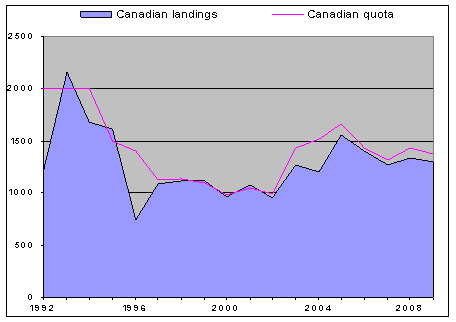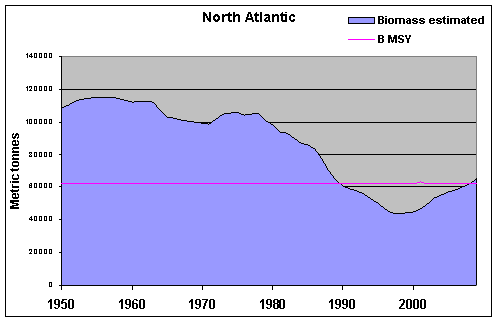Swordfish

- Name:
- Swordfish
- Latin Name:
- Xiphias gladius
- Group Name:
- Pelagic fish
- Location:
- Atlantic Ocean
- Fishing Gear:
- Longline and harpoon
- Fishing Season:
- April to December
Species at a Glance
Swordfish are highly migratory fish ranging throughout the Atlantic Ocean and the Mediterranean Sea. They are managed by the International Commission for the Conservation of Atlantic Tunas, which establishes quota allocations for each of the Commission’s 48 contracting parties.
Management of the North Atlantic swordfish fishery is a Canadian and international success story. Today, the fishery is sustainable, well controlled, and monitored. The International Commission for the Conservation of Atlantic Tuna (ICCAT), supported by Canada and other partners, introduced a 10-year recovery plan in 1999 to rebuild the stock and today, scientific assessments confirm that the North Atlantic Swordfish stock has been fully rebuilt.
- Landings:
-
Canadian swordfish annual landings averaged 1,200 to 1,300 tonnes in the last decade. In 2013 1,505 t were landed. In 2012, landed quantities were 1,485 t and in 2011, landed quantities were 1,554 t. In 2010, 1,345 tonnes were landed.
- Value:
- 100 percent of the swordfish landed in Atlantic Canada is exported to the United States. In 2013, the export value was $12.3 million and in 2012 the export value was $10.6 million. In 2011, overall export value was $14.4 million. The 2010 landed value was $10.5 million.
- Abundance status and trends:
- The estimated relative biomass trend of the North Atlantic swordfish shows a consistent increase since 2000. There is a general downward trend in landings since 2005. However, it remains above the last 15-years landing average.
- Fisheries:
- There are 77 Canadian licence holders in the longline fleet and more than 1200 harpoon-only licences. In 2009, only 52 longline licences were active and fewer than 100 licence holders in the harpoon sector reported landings.
- Conservation Measures:
- An important conservation element is the fishery’s relatively low level of effort, ensured in part through limitations in the number of authorized licences, quota, gear restrictions, and targeted time and area closures. Minimum size limits are also in place to protect juvenile fish and help ensure the future of the stock.
Species Background
Swordfish are highly migratory pelagic fish and transboundary in their distribution throughout the Atlantic Ocean and the Mediterranean Sea. Swordfish migrate into the Canadian Exclusive Economic Zone during summer and fall to feed in the fertile waters of the continental slope and shelf basins areas.
As a species group, individuals tend to be large, and can often exceed 100 kilograms. The largest recorded swordfish was 4.5 metres long and weighed 537 kilograms.
Adult swordfish have few natural predators with the possible exception of sharks, so predation is thought to have little influence on swordfish abundance. They feed on a wide variety of prey, including groundfish, pelagics and invertebrates.
Tagging studies have shown that swordfish can live up to 15 years, although 10 years is considered the typical maximum age.
Fisheries
The swordfish fishery is socially and economically important to communities throughout Atlantic Canada.
Swordfish is caught by pelagic longline or harpoon gear. The harpoon fleet is allocated 10 percent of the Canadian swordfish quota, the predominant longline fishery accounts for 90 percent of the annual harvest. The longline fleet is also permitted to harvest using harpoon gear, and will annually harvest between five and 10 percent of the fleets quota with that gear type.
Harpooning for swordfish currently occurs primarily along the edges of Georges and Browns Banks, and targets mainly the large female swordfish swimming in surface waters during the day. The Canadian large pelagic longline fishery extends from Georges Bank, south of Nova Scotia to beyond the Flemish Cap east of Newfoundland when swordfish, the main species targeted, migrate into the Canadian Exclusive Economic Zone (EEZ).
In June 2010, the harpoon fishery received Marine Stewardship Council certification for being a sustainable and well-managed fishery. Canada’s Northwest Atlantic pelagic longline fishery has been awarded Marine Stewardship Council (MSC) certification in April 2012. To learn more about this assessment process, visit the MSC Web site.
Conservation Measures
Management of the swordfish fishery relies first and foremost on the best available science advice.
Canadian scientists are leading international efforts to learn more about swordfish migration and biology. They are supported in those efforts by Canadian swordfish harvesters, who understand the importance of sustainability for the future of the fisheries. Harvesters offer their expertise and experience in the development of Canada’s Integrated Fisheries Management Plans.
All fishing activities must be recorded in DFO-approved logbooks and in the manner prescribed by the Department. This includes providing information on all discards, dead or alive. Swordfish harvesters must also abide by strict licence conditions, which include:
- areas closed to fishing to protect swordfish broodstock, to prevent bycatch of bluefin tuna, and to protect sensitive areas like the Gully Marine Protected Area on the Scotian Shelf;
- minimum fish size restrictions;
- requirements to hail out and hail in for all fishing trips;
- dockside monitoring of all landings;
- requirements for proper handling and release of identified species-at-risk including leatherback turtles.
Canada takes a comprehensive approach to enforcement that includes sophisticated vessel monitoring systems on all longline vessels, aerial surveillance, dockside monitoring, and at-sea observers.
Engaging industry
Industry is fully engaged in the conservation and management efforts for this species to ensure its sustainability, including funding independent at-sea observers to monitor the fishery. (The harpoon fleet has provided support for scientific research in lieu of at-sea observer coverage). Due to the nature of the longline fishery, reducing bycatch and dead discards is also important. To that end, the industry, working closely with Fisheries and Oceans Canada, has implemented a number of mitigating measures, such as:
- using circle hooks, which are believed to reduce non-target species bycatch rates and to increase the probability of post release survival;
- practicing live release, to the extent possible, of all sensitive species;
- landing, reporting, and marketing non-target harvests to minimize resource waste; and
- collaborating with Fisheries and Oceans Canada in a research program examining patterns of bycatch in the pelagic longline fishery, with a view to mitigate catches of sensitive species.
The pelagic longline fleet must follow a code of conduct for the handling and release of marine turtles. All active vessels are also equipped with turtle de-hooking kits and dipnets to help handle and release marine turtles with as little harm as possible.

Swordfish Landings – Historical View
Figure 1 is captioned “Swordfish landings-historical view”. It is a two-dimensional chart column featuring the historical view of swordfish landings in tonnes by Canadian harvesters. Canadian landings are shown from 1992 to 2008, with individual years listed along the x-axis and landings in 500-tonne increments from 0 to 2,500 t listed along the y-axis. Beginning in 1996, the figure shows that the Canadian landings increased slightly over 1996 to 2008 and follow the quota estimates. Quotas are illustrated as a line above the Canadian landings.
Over the past decade, total landings in Canada peaked at 1,664 tonnes in 2005. Since 2003, the catches of North Atlantic swordfish by ICCAT fishing nations have been below the total allowable catch level, greatly increasing the chances for a fast recovery.
Population Estimates
Due to the highly migratory nature of swordfish, scientists rely primarily on data derived from the commercial fishery. Canada, as a member of ICCAT, is obligated to provide catch, catch-at-size, and catch-per-unit-effort information annually to ICCAT. Mandatory submission of detailed log records, dockside monitoring, observer coverage, and taking biologists aboard vessels are all part of the data collection process. This information is used by ICCAT scientists to conduct stock assessments. Full stock assessments for swordfish are generally conducted every three to four years. The last assessment for Atlantic swordfish was conducted in 2009.
The stock assessment results are made available to the public through the International Commission for the Conservation of Atlantic Tunas.

Swordfish Biomass – Historical View
Figure 2 is captioned “Swordfish biomass-historical view”. It is a two-dimensional chart column featuring the historical view of swordfish biomass estimates in metric tonnes in the north Atlantic by Canadian harvesters. The biomass trend is shown from 1950 to 2010, in 20,000-tonne increments from 0 to 140,000 tonnes listed along the y-axis. In the year 1950 the estimated biomass was high and declined slightly until 2000. Since then, the biomass has increased moderately.
The estimated relative biomass trend shows a consistent increase in this stock since 2000. The current results indicate that the stock is at or above sustainability levels. (MSY) is the largest average catch or yield that can continuously be taken from a stock under existing environmental conditions. BMSY is simply the biomass that produces MSY.
Additional Information
- Date modified: